BMC FootPrints v11 Integration
BMC FootPrints is a flexible, comprehensive, integrated IT service and asset management platform that is easy to install, use, and extend to create business value. BMC FootPrints is a web-based, on-premise solution that is quick to install and easy to use.

What does Opsgenie offer BMC FootPrint users?
Opsgenie provides a powerful two-way integration with BMC FootPrints. When a new incident or problem is created in BMC FootPrints, a corresponding Opsgenie alert is automatically created, containing rich information about the incident. Opsgenie provides rich notifications with on-call rotations, scheduling features, and alert escalations to ensure the best incident management for BMC FootPrints customers.
Functionality of the Integration
- When an incident is created in BMC FootPrints v11, an alert is created in Opsgenie.
- When an incident is updated in BMC FootPrints v11, a note is added to the alert in Opsgenie.
- When an incident is resolved in BMC FootPrints v11, the alert is closed in Opsgenie.
- When a problem is created in BMC FootPrints v11, an alert is created in Opsgenie.
- When a problem is updated in BMC FootPrints v11, a note is added to the alert in Opsgenie.
- When a problem is resolved in BMC FootPrints v11, the alert is closed in Opsgenie.
- When an alert is created in Opsgenie, an incident or a problem is created in BMC FootPrints v11.
- When a note is added to the alert in Opsgenie, the incident or the problem is updated in BMC FootPrints v11.
- When the priority of the alert is changed in Opsgenie, the priority of the incident or the problem is updated in BMC FootPrints v11.
- When the alert is closed in Opsgenie, the incident or the problem is resolved in BMC FootPrints v11.
Add BMC FootPrints v11 Integration in Opsgenie
- Create an Opsgenie account, if you haven't done so already.
- Go to Opsgenie BMC FootPrints v11 Integration page.
- Specify who is notified of BMC FootPrints v11 alerts using the Teams field. Auto-complete suggestions are provided as you type.
- Copy the API key.
- Click Save Integration.
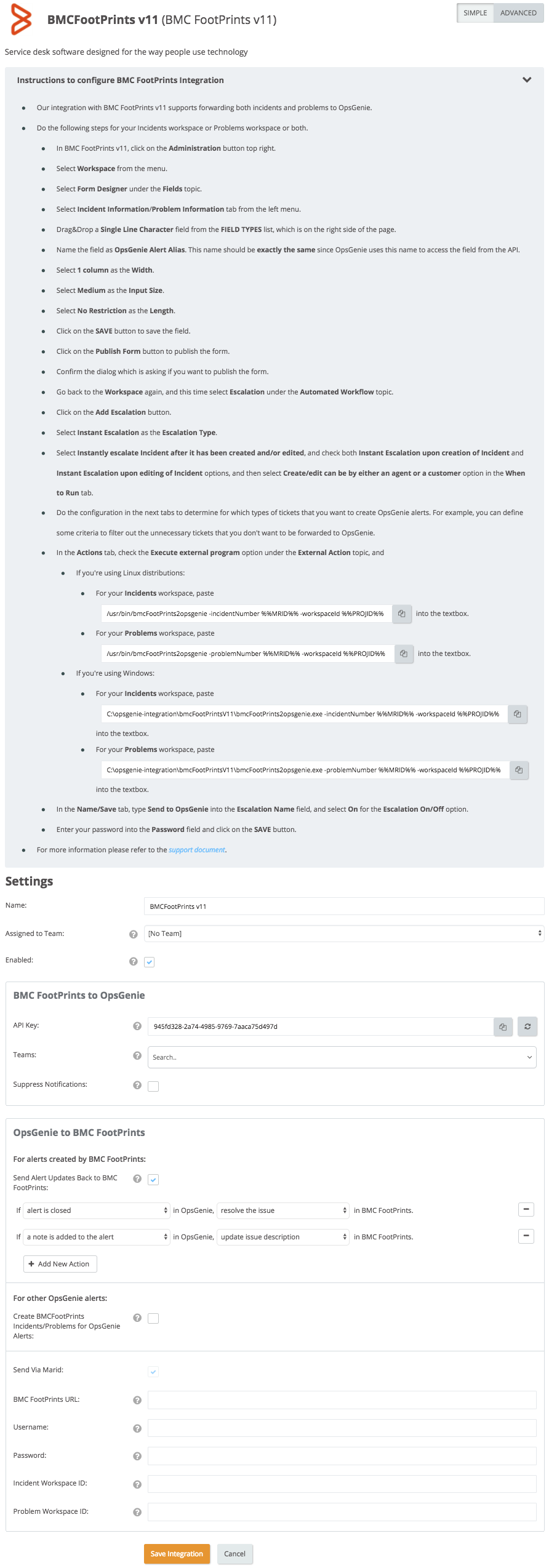
Configuration in BMC FootPrints v11
- Our integration with BMC FootPrints v11 supports forwarding both incidents and problems to Opsgenie.
- Take the following steps for your Incidents workspace or Problems workspace or both.
- In BMC FootPrints v11, click the Administration button at top right.
- Select Workspace from the menu.
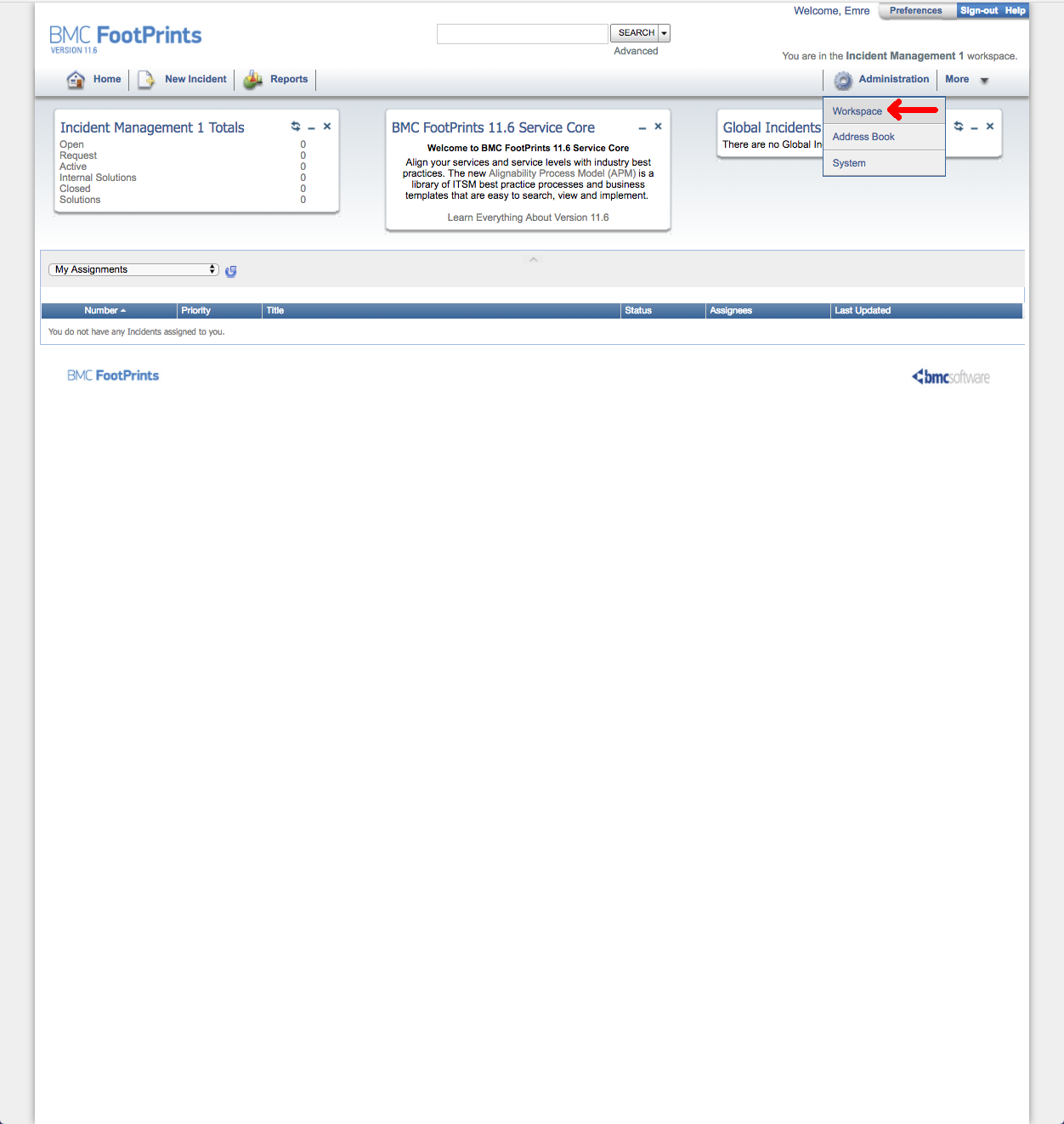
-
- Select Form Designer under the Fields topic.
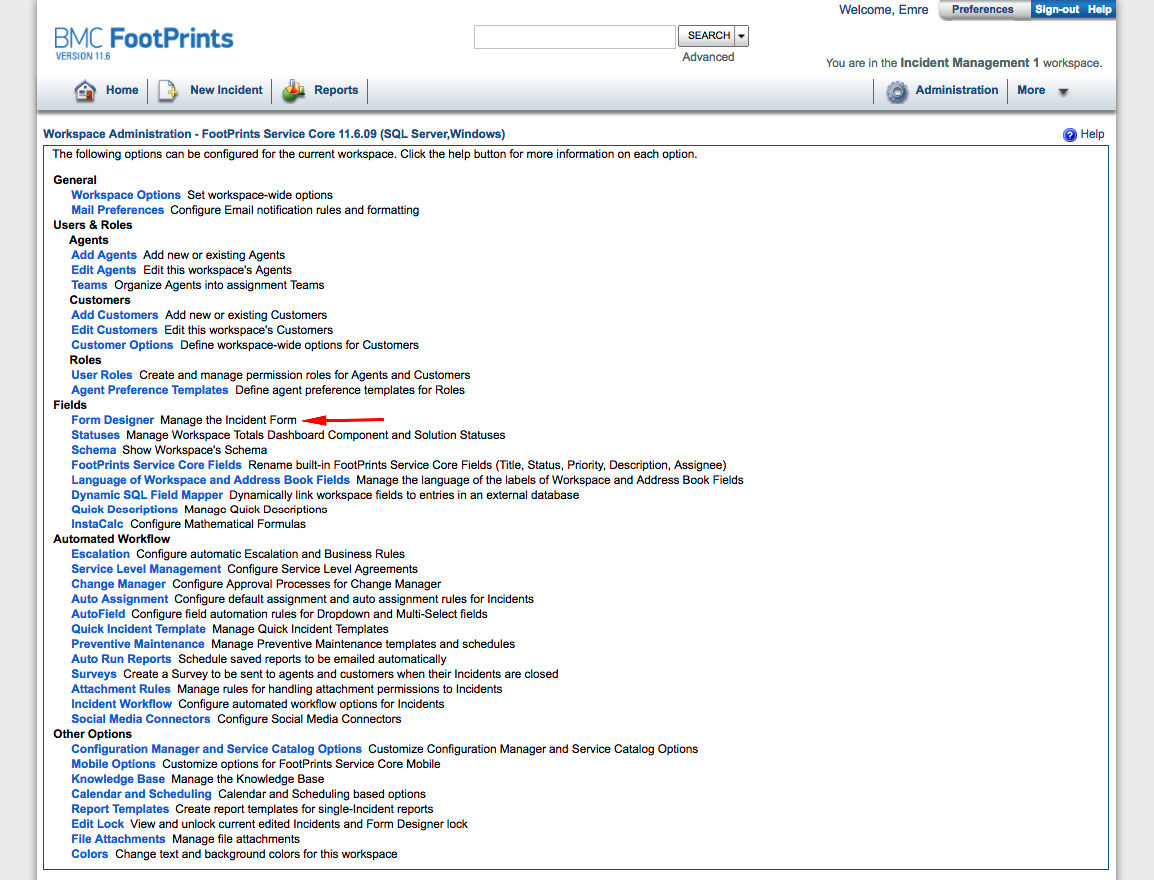
-
- Select Incident Information/Problem Information tab from the left menu.
- Drag&Drop a Single Line Character field from the FIELD TYPES list on the right side of the page.
- Name the field: Opsgenie Alert Alias. This name should be exactly the same since Opsgenie uses this name to access the field from the API.
- Select 1 column as the Width.
- Select Medium as the Input Size.
- Select No Restriction as the Length.
- Click SAVE to save the field.
- Click Publish Form to publish the form.
- Confirm the dialogue which asks if you want to publish the form.

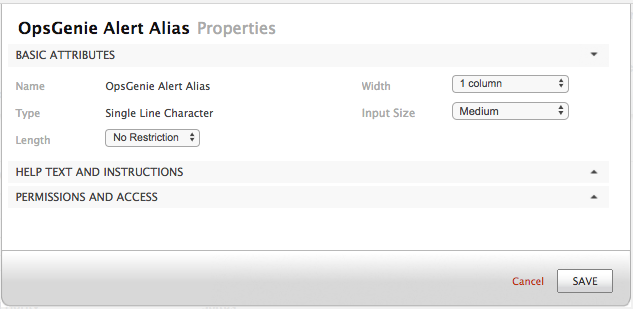
-
- Go back to the Workspace again, this time select Escalation under the Automated Workflow topic.

-
- Click Add Escalation.
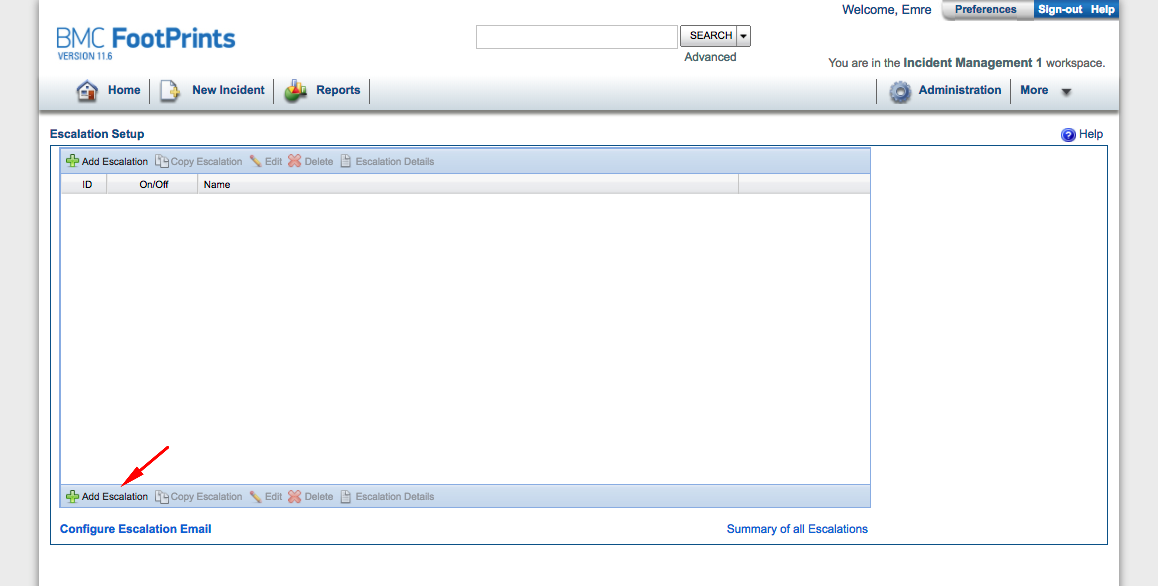
-
- Select Instant Escalation as the Escalation Type.
- Select Instantly escalate Incident after it has been created and/or edited, and check both Instant Escalation upon creation of Incident and Instant Escalation upon editing of Incident options, then select the Create/edit can be by either an agent or a customer option in the When to Run tab.

-
- Complete configuration in the next tabs to determine for which types of tickets that you want to create Opsgenie alerts. For example, define the criteria to filter out the unnecessary tickets that you don't want to be forwarded to Opsgenie.
- In the Actions tab, check the Execute external program option under the External Action topic, and
- If you're using Linux distributions:
- For your Incidents workspace, paste /usr/bin/bmcFootPrints2opsgenie -incidentNumber %%MRID%% -workspaceId %%PROJID%% into the textbox.
- For your Problems workspace, paste /usr/bin/bmcFootPrints2opsgenie -problemNumber %%MRID%% -workspaceId %%PROJID%% into the textbox.
- If you're using Windows:
- For your Incidents workspace, paste C:\opsgenie-integration\bmcFootPrintsV11\bmcFootPrints2opsgenie.exe -incidentNumber %%MRID%% -workspaceId %%PROJID%% into the textbox.
- For your Problems workspace, paste C:\opsgenie-integration\bmcFootPrintsV11\bmcFootPrints2opsgenie.exe -problemNumber %%MRID%% -workspaceId %%PROJID%% into the textbox.
- If you're using Linux distributions:
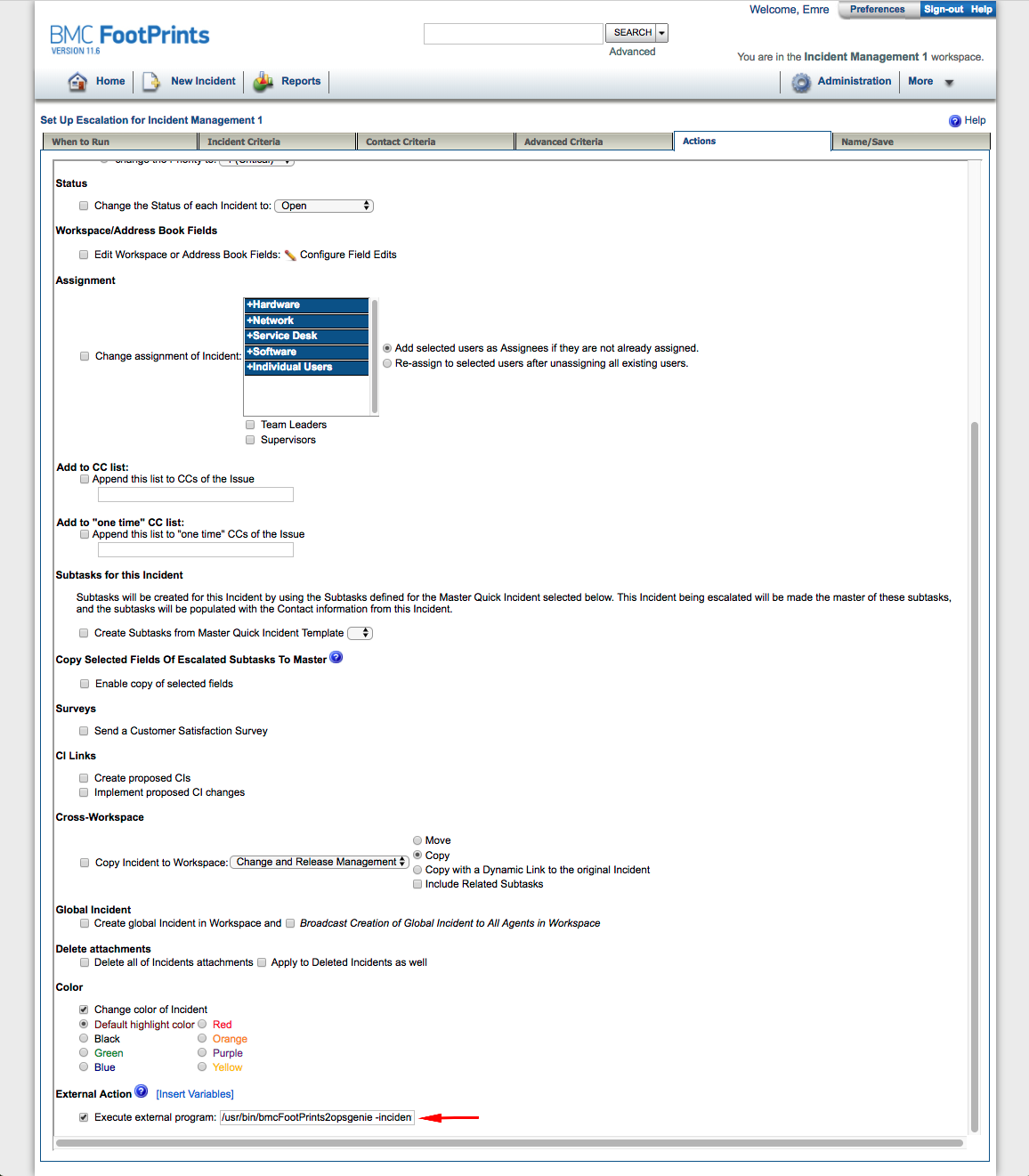
-
- In the Name/Save tab, type Send to Opsgenie into the Escalation Name field, and select On for the Escalation On/Off option.
- Enter your password into the Password field and click SAVE.

Integration via Marid
Use Opsgenie's BMC FootPrints v11 integration package to create/update/resolve incidents or problems in BMC FootPrints v11. This will enable you to deploy your own scripts / modify the ones provided and execute customized actions on BMC FootPrints v11.
To use BMC FootPrints v11 integration package, you need to follow the steps in the sections below through the end.
In order to use this feature, "Create BMCFootPrints Incidents/Problems for Opsgenie Alerts" checkbox should be enabled in Opsgenie BMC FootPrints v11 integration configuration page.
Download and install BMC FootPrints v11 package
For Red Hat Based Distributions
- Download Opsgenie BMC FootPrints v11 (Linux RPM)
- Run the following command :
rpm -i opsgenie-bmcfootprints-v11-<your_version>.rpm
During upgrades, rpm package does not overwrite your existing configurations. It saves the new default configuration file as opsgenie-integration.conf.rpmnew. You can find more information about rpm upgrade config file handling from here.
For Debian Based Distributions
- Download Opsgenie BMC FootPrints v11 (Linux DEB)
- Run the following command :
dpkg -i opsgenie-bmcfootprints-v11_<your_version>.deb
For Windows
- Download Opsgenie BMC FootPrints v11
- Unzip opsgenie integration zip file which contains Marid package into a directory (C:\opsgenie-integration is the preferred path. C:\opsgenie-integration\marid will be referred as MARID_HOME in the rest of documentation.)
- To install Marid as a service:
- Open a command window
- Go to <MARID_HOME> directory
- For 32 bit systems, run marid.exe -install
- For 64 bit systems, run marid_64.exe -install
- Name of the service will be assigned to "OpsGenie Marid"
To set JAVA_HOME environment variable, refer to Setting JAVA_HOME for more information.
To enable Ruby scripting, you need to download JRuby Complete jar file and put this jar file in lib directory (/var/lib/opsgenie/marid On Linux, MARID_HOME/lib on Windows systems.).
You may need to restart your system after setting JAVA_HOME environment variable for Windows XP/2000/2003 operating systems due to problem reported at **http://support.microsoft.com/kb/821761
Configuring BMC FootPrints v11 Integration for Marid
If you are using Opsgenie Edge Connector instead of Marid, you can find the integration specific script and its sample config from here. For more information about OEC, please refer OEC Integration documentation
- Configurations regarding BMC FootPrints v11 can be done either via integration page or Marid configuration file opsgenie-integration.conf. The configuration in the integration page will precede the configuration file.
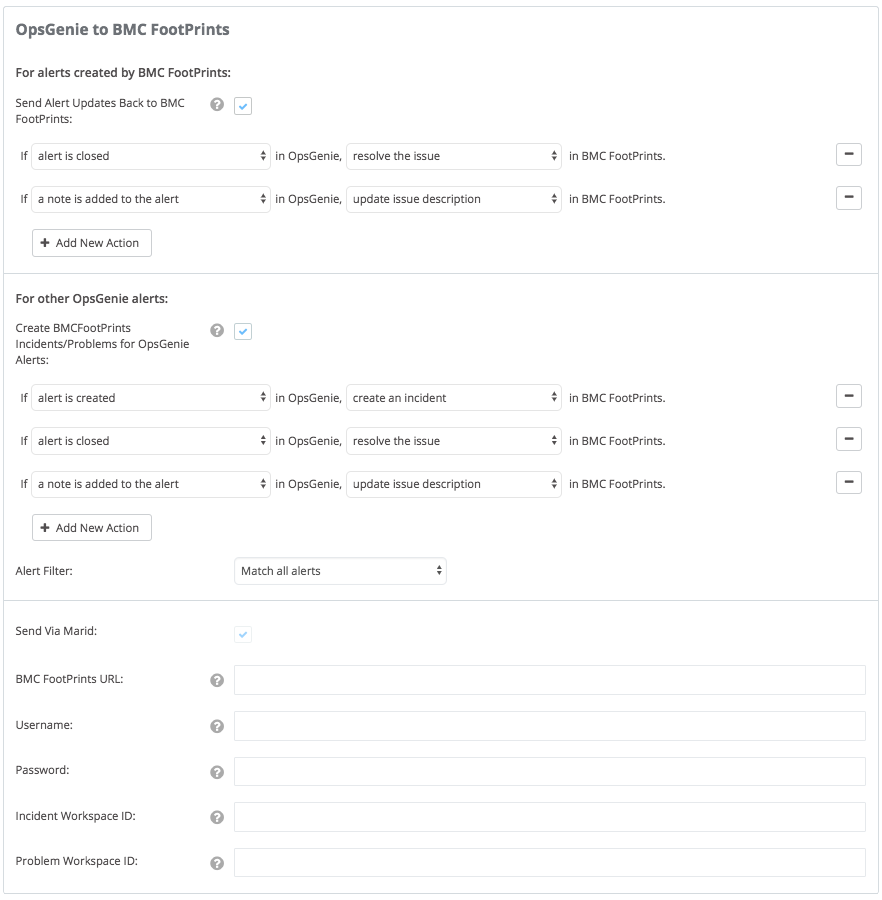
Marid Configuration
The integration uses Marid utility (included in the package) to create/update/resolve incidents/problems in BMC FootPrints v11 when alerts are updated in Opsgenie.
To start Marid, Open Command Prompt
- For Windows:
- Go to <MARID_HOME> directory and run the following command.
- For 32 bit systems:
marid.exe -start - For 64 bit systems:
marid_64.exe -start
- For Linux:
sudo /etc/init.d/marid start
To stop Marid, run the following command:
- For Windows:
- Go to <MARID_HOME> directory and run the following command.
- For 32 bit systems:
marid.exe -stop - For 64 bit systems:
marid_64.exe -stop
- For Linux:
sudo /etc/init.d/marid stop
To be able to execute actions in BMC FootPrints v11, Marid gets the configuration parameters from C:/opsgenie-integration/conf/opsgenie-integration.conf file in Windows and /etc/opsgenie/conf/opsgenie-integration.conf file in Linux.
Configuration Parameters | |
|---|---|
apiKey | Copy the API key from the BMC FootPrints v11 integration you've created above. |
logPath | Specifies the full path of the log file for bmcFootPrints2opsgenie. (Default value is /var/log/opsgenie/bmcFootPrints2opsgenie.log for Linux and C:\opsgenie-integration\bmcFootPrints2opsgenie.log for Windows.) |
bmcFootPrints2opsgenie.logger | Specifies the log level for bmcFootPrints2opsgenie. (Default value is warning) |
bmcFootPrints.url | URL of your BMC FootPrints v11 instance. |
bmcFootPrints.username | Username of your BMC FootPrints v11 user for authentication. |
bmcFootPrints.password | Password of your BMC FootPrints v11 user for authentication. |
bmcFootPrints.incidentWorkspaceId | ID of your Incidents workspace in BMC FootPrints v11. (E.g. 6) |
bmcFootPrints.problemWorkspaceId | ID of your Problems workspace in BMC FootPrints v11. (E.g. 7) |
bmcFootPrints2opsgenie.http.proxy.enabled | bmcFootPrints2opsgenie.http.proxy.enabled field is to enable/disable external proxy configuration. The default value is false. |
bmcFootPrints2opsgenie.http.proxy.host | It is the host of the proxy. |
bmcFootPrints2opsgenie.http.proxy.port | It is the port of the proxy. |
bmcFootPrints2opsgenie.http.proxy.protocol | It is the proxy connection protocol. It may be http or https depending on your proxy servers. Its default value is http. |
bmcFootPrints2opsgenie.http.proxy.username | It is the Proxy authentication username. |
bmcFootPrints2opsgenie.http.proxy.password | It is the Proxy authentication password. |
opsgenie.api.url | If you're using Opsgenie from another domain(eg. EU, sandbox), you should update this configuration. |
According to the action that will be executed in BMC FootPrints v11, the script to be run can be set here. Opsgenie's script is set by default; you can change the following configuration to run your own custom script if you like.
Action Mapping | Script File |
|---|---|
mappedActions.createIncident.script | bmcFootPrintsActionExecutor.groovy |
mappedActions.createProblem.script | bmcFootPrintsActionExecutor.groovy |
mappedActions.updateDescription.script | bmcFootPrintsActionExecutor.groovy |
mappedActions.updatePriority.script | bmcFootPrintsActionExecutor.groovy |
mappedActions.resolveIssue.script | bmcFootPrintsActionExecutor.groovy |
Sample parameters sent to Marid
{
"type": "bmcFootPrintsV11",
"alertId": "ccec1231-9cbf-468c-a6ce-c52a18712404",
"customerId": "c32f2305-f7ad-4fed-8d85-2f3cae411983",
"action": "Create",
"mappedActionV2": {
"name": "createIncident",
"extraField": ""
},
"integrationId": "5769475e-ddc6-4978-812e-50ed2aab9a5b",
"integrationName": "BMCFootPrints v11",
"integrationType": "BMCFootPrintsV11",
"sendViaMarid": true,
"url": "",
"username": "",
"password": "",
"incidentWorkspaceId": "",
"problemWorkspaceId": "",
"title": "Test message.",
"priority": "P3",
"description": "[Opsgenie] Test description.",
"alertAlias": "ccec1231-9cbf-468c-a6ce-c52a18712404"
}Updated 7 months ago
